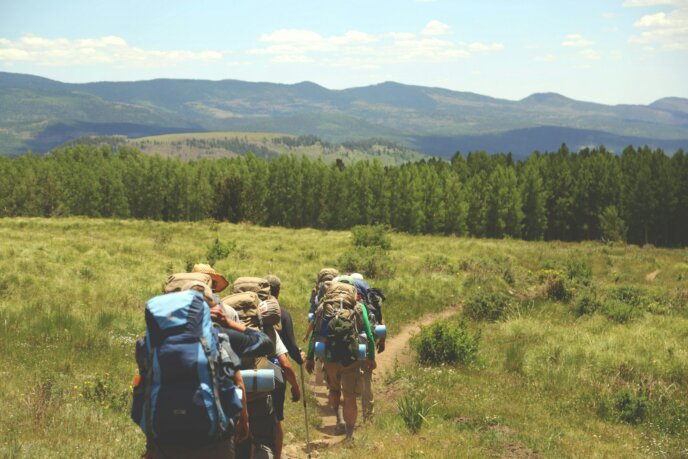What’s Behind the Gear: A Closer Look at Trail Essentials
Learn how to gear up properly for unforgettable outdoor adventures in Niseko’s iconic natural landscapes, get ready for whatever the wild has in store.
When exploring the stunning trails of Niseko, what you pack can make or break your adventure. From the right shoes to lightweight layers, having the proper gear ensures comfort, safety, and confidence, whether you're hiking to Mt. Yotei’s summit or jogging through forested paths. In this guide, we take a closer look at what gear works best for Niseko’s unique terrain and weather, breaking it down by essentials, nice-to-haves, and expert extras. Whether you’re new to the trails or levelling up your kit, here’s everything you need to feel fully prepared out there.
Head to Toe: What to Wear on Niseko’s Trails
Your shoes can be one of the most important pieces of gear for any hike or trail run. They carry you through every step, so comfort, fit, and function are absolutely essential. While it is not a must, consider shoes with a waterproof construction, as many trails in the Niseko area stay damp long after rainfall. Good grip is also key, strong traction helps you navigate slippery stones, muddy paths, and uneven terrain with confidence. For longer hikes or runs, cushioned soles reduce impact and keep your legs and feet feeling fresher for longer. The cut of the shoe also matters: mid-cut models are often enough for experienced hikers, while high-cut boots provide extra ankle support, ideal for rugged, rocky trails or those carrying a heavier pack.
Start with breathable shorts or lightweight hiking trousers, depending on the terrain and temperature. For your top layer, choose a moisture-wicking T-shirt, either short or long-sleeved based on your preference and sun protection needs. If you opt for short sleeves, don’t forget to apply sunscreen generously to exposed skin. A light, packable rain jacket or windbreaker is essential for dealing with sudden shifts in weather. Top it off with a wide-brimmed hat or cap to shield you from the sun, and add a pair of sunglasses for eye protection on brighter days. Dressing in light, functional layers helps you stay comfortable and ready for whatever the trail throws your way.
Pro tip: Pack an extra shirt and thicker layer so you can change into a dry layer during longer breaks, especially on windy ridgelines or after steep climbs. Staying dry helps you regulate body temperature and stay comfortable for the rest of your outing.

Essential Extras: From Backpacks to Trail Tools
A day out in the greens calls for more than just a bottle of water. To carry everything you need comfortably, we recommend a backpack with a volume of around 20–30 litres. This size gives you enough room for layers, food, water, and extras, without being bulky on shorter outings. Look for a lightweight design with a ventilated or mesh back panel to reduce sweat buildup, and make sure it has padded, adjustable waist and chest straps for better weight distribution. If your backpack isn’t waterproof, pack a compact rain cover in one of the outer compartments to keep your gear dry when the weather turns.
For trail runners, a running vest is a great alternative. Minimal weight is key, so look for one with soft flasks or a hydration bladder to avoid stopping and taking the vest off. Front-access pockets are ideal for stashing gels, snacks, and your phone, while adjustable straps help ensure a bounce-free, comfortable fit. For most runs, choose a vest with at least 7–8 litres of storage space, enough to carry a lightweight jacket and other essentials.
Hiking poles can be a great help, especially on steep or uneven trails. They ease the strain on your knees and improve balance by distributing effort across your body. Foldable or telescopic poles are ideal, easy to adjust and simple to stash in your bagpack or vest quiver when not in use. Packing a small towel is a handy extra, perfect for cooling off your feet in a fresh mountain stream or wiping away sweat on warmer days. For safety, it’s a good idea to attach a bear bell and whistle to your pack. While bear sightings in the Niseko area are rare, the sound helps alert wildlife to your presence and adds peace of mind on the trail. With wildlife in general, insects can be particularly persistent during Niseko’s hot and humid summer months, so bringing insect repellent is a smart idea.Lastly, your basic kit should include simple first aid supplies, tweezers, and any personal allergy medication. Keep it within easy reach, ideally stored alongside a multi-tool or small knife.

Stay Fuelled and Hydrated on the Trail
A common challenge for hikers and runners in summer is feeling sluggish or overly tired after spending time outdoors. While part of this is natural trail fatigue, many underestimate just how important it is to properly fuel and hydrate the body, both during the activity and afterwards.
As temperatures rise, your body loses more fluid in its effort to stay cool. Humidity makes it even harder to regulate temperature, meaning you’ll sweat more without actually feeling cooler. Replenishing that lost fluid is essential for a safe and enjoyable outing. Aim to drink at least 500 ml of water per hour, or more on especially hot days. Since sweat also flushes out essential nutrients, consider adding electrolytes to part of your hydration plan to maintain energy and avoid fatigue.
Physical effort also burns through your energy reserves, so it’s important to refuel as you go. Whether you prefer frequent small snacks, like fruit, energy gels, trail mix, or bars, or longer breaks with more substantial options like onigiri (rice balls), sandwiches, or dried meals, make sure you’re giving your body the fuel it needs to keep going strong.
Now that you're packed and prepared, you're ready for your next outdoor adventure!